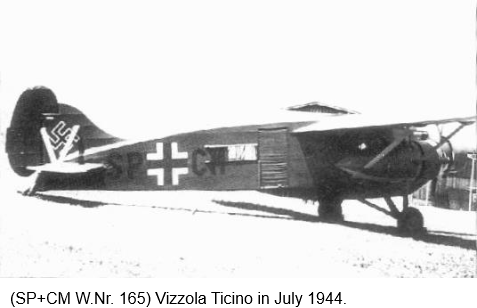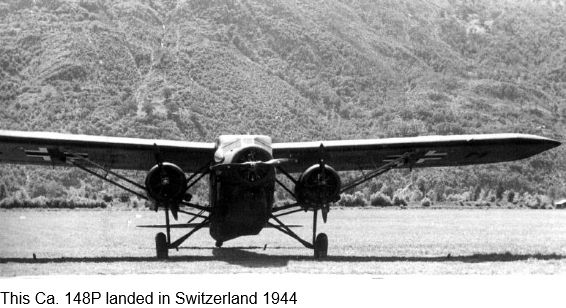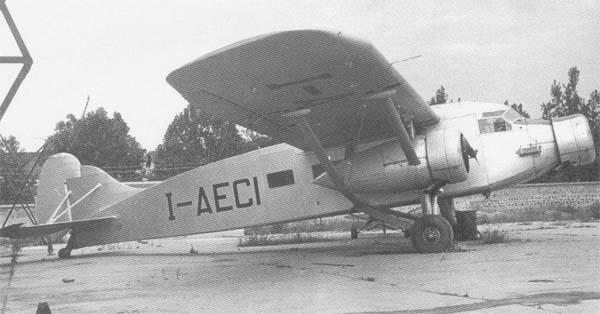The project is due to an initiative of the owner and designer Gianni Caproni who, assisted by Agostino Caratti and technical office, he decided to further develop the Ca.133 intervening in certain aspects of the original design to improve aerodynamics and overall, consequently, the performance.
Work on developing the new model, which was given the designation Ca.148, began in 1938. Externally did not depart from the general lines of his predecessors that stemmed from the single-engine Ca.97 of 1927, or mixed construction with tubular frame welded steel rectangular section, high-wing braced solid uprights cross, and fixed gear, as the Ca.133, propulsion system based on the same three radial engines Piaggio P.VII. The differences over its predecessor were in the placement of the cockpit, now advanced by 0.91 m, in the transfer of the main entrance and in the structural improvement of the frame that gave the Ca.148 look more solid.
For a comparative test the model failed to achieve superior performance of Ca.133, however, the need for new units to be sent in the territories of Eastern Italian Caproni guaranteed equally to a supply contract for 106 specimens , of which 100 version Ca.148P (magnified in the fuselage) the use of which comprised the transport of parachutists .
Unlike its predecessors, designed as a multi-role, the Ca.148 were used exclusively in the role of tactical transport aircraft, as equipment of the various departments of transportation of the Royal Air Force stationed in AOI.
Upon conclusion of the fighting in AOI, some of the surviving examples (perhaps only one, registration I-ETIO were required in Europe remained in service until the end of World War II in both Italy,and after the requisition by the German personnel of the Wehrmacht after the armistice of Cassibile, even the Luftwaffe.
After the end of the conflict, some specimens were converted to airliners, identified with the designation Ca.148P, who worked in the airlines on short-haul routes to the end of their operational life, in the late forties
After the armistice, the Germans found three new Ca.148 at Vizzola and authorized the company to continue production up to the 40th aircraft.
By December 1942 Ca.148 "MMM012" (possibly a misprint for 61072) was in use at Rosebron-Zopten loith the local second stage flying school FFS B20. Accident reports and other sources confirm the Luftwaffe use of aircraft MM.61147, 61149, 61150, 61151, 61163, 61171 and 61180.
By March 1944 the Germans employed 13 Ca.148, apparently rising to 32 in June arid serving wih the Wittstock, Rechlin and Papa paratrooping schools. Two Ca. 148 were destroyed by strafing at Gallarate on 31 July 1944.
| Type |
2 + max. 18 passengers, used at parachutist training schools |
| Engine |
3 Piaggio Stella P.VII C168 |
| Dimensions |
Length 15,83 m, height 4,00 m, span 21,44 m, wing area 65,00 m2 |
| Weights |
Empty 4787 kg, flying weight 8000 kg |
| Performance |
Max. speed 241 km/h at 3900 m, 225 km/h at sea level, min. speed 135 km/h, cruising speed 200 km/h, range 900 km, service ceiling 3900 m, climb to 2000 m 13 min. |
| Type |
Werk.Nr |
Registration |
History |
|
61147 |
|
Fallschirmschule 3. Destroyed 24 April 1944 at Kraljewo by ground attack |
|
61149 |
SB+BH |
|
|
61150 |
|
|
|
61151 |
|
|
|
61163 |
|
Fallschirmschule 2. Destroyed August 1944 at Wittstock |
|
61171 |
|
Fallschirmschule 1. 20 % damaged 16 August 1944 at Mörsch/Karlsruhe, emergency landing caused by engine problem. |
|
61180 |
|
|
|
|
SB+CM |
IV./KG 30 |
|
61155 |
SP+BN |
|
|
61156 |
SP+BO |
|
|
|
SP+CM |
|
|
|
SR+BH |
|
|
|
|
|
|
|
|
|
|
|
|
|





